|
Thursday, April 9, 2015
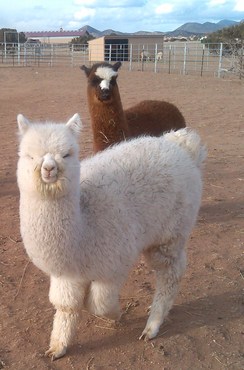
As most of you know, I enjoy participating in Alpaca shows…I think I’ve learned a lot from both halter shows and fleece shows. I often hear other exhibitors express confusion or dismay over their placings - “Well, I thought he was a really nice boy…can’t figure out why we only got fourth place!” We’ve all had those moments. But I have come to realize that in the current development of the North American alpaca herd, the difference between first place and sixth place is becoming narrower and narrower.
I recently entered two white fleeces in a medium sized fleece show. I love both of these boys, they are the same age, both bright white, dense, crimpy, fine and sweet dispositions and I have always been hard pressed to pick which is the better of the two. They competed in halter classes but never at the same show – I just hate to have two animals competing against each other in a halter class – that’s just me, I just don’t like to do it. But there’s less pain with a fleece show because it all happens behind closed doors – there’s no agony while the judge makes her decision, there’s no room full of people looking on. But I am really glad I put these two fleeces in side by side as it were – I learned a valuable lesson.
One fleece placed 2nd out of eleven and one placed 6th. Same class – white yearling males. Would you like to know how many points divided them? Two…two points! Still…2 points – I really wanted to know what I had missed on Baloo – I thought they were closer than that. So I looked at their individual scores – that is the very best thing about fleece shows – it’s all there in black and white – what the judge saw, what he liked, what he didn’t like. And fleece scores are not predicated on comparison to the other entries in the class – fleeces are judged on what the industry holds as ideal. Sooo – fineness and handle…same score, length, half a point difference, micron, half a point difference the other way…so we’re even again. Color, same…they are both white with no color contamination. Character (that deals with the architecture of the fleece, crimp style, organization of the staples…that sort of thing) half a point but both good scores, density, same score. Absence of Guard Hair – same score, 8, Impurities and Stains – good, same. Weight – ah ha – here we go…1 ½ of those points was due to weight differential. Poor Baloo is a bit of a Pigpen and I had to skirt a lot of his tail feathers – beautiful fiber but oh so dirty! So, basically my original assessment of these boys was correct – they are both gorgeous and there is not much difference in their fleeces (huge difference in their personalities – Baloo is the class clown, Comanche is very dignified) but the weight score made the difference between 2nd place and sixth place.
So my advice to all exhibitors – take the time to go look at the animals that placed higher than yours…and be objective. And if you really can’t see why the judge placed that animal over yours, take the time to talk to the judge at the end of the show, or ask another experienced breeder to look at both animals and give you an opinion. And don’t quit showing that animal. If it placed you are probably correct to think it is show quality – we’ve done an excellent job here is the US over the past few years in improving the quality of the animals we are producing. I go to shows and my head wants to explode – there are so many gorgeous creatures there. And the difference between first and sixth is usually very hard to find. I wouldn’t have the job of alpaca judge for all the tea in China!
Click the picture below to see the score sheets!
|
|
Thursday, March 26, 2015
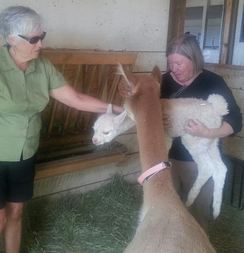
We’ve talked a lot about alpacas in these blog posts, and we hope you have found them to be interesting and entertaining. We wanted to share a few more facts that we thought you’d find fun and worth reading! Even though I know a lot about alpacas, I still find there is more and more to learn everyday with these amazing creatures. Young or old, alpacas have a lot of love and fun to offer us and I think there is no better way to love them back than to learn more about what makes them so special.
The first interesting fact I’d like to share with you is that alpaca wool is actually water resistant! Alpaca fiber is similar to cotton which is why their fleece is light and airy when you wear it. Alpaca fibers are the perfect choice when you are looking to stay warm and dry!
Next up is that alpaca fibers come in a wide variety of different hues. Believe it or not, there are actually sixteen different tones that you can choose from! You can be sure there will be a color for everyone in the family!
Last but not least, alpacas come in two types: Suri and Huacaya. While the Suri has long twisted locks sort of like dreadlocks, the Huacaya has fleece that is crimped similar to a teddy bear. If you’ve ever wondered why some alpacas look so different, now you have your answer!
Alpacas are unique animals with so many interesting facts! We hope to share all of these facts with you along the way!
Do you know any interesting alpaca facts?
|
|
Wednesday, March 11, 2015
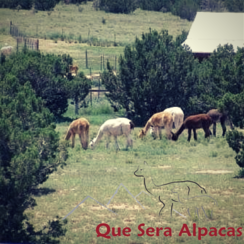
Obviously, not everyone is cut out to start raising alpacas. They require a lot of love and care and there is a lot that most people don’t know to think about. Just like any creature that needs nurturing, you need to realize the difficulties involved in raising alpacas. They are wonderful creatures and amazing to have around, but no one wants to adopt a sweet animal only to realize they can’t properly take care of them. So, what are some of the points you should consider before raising alpacas? Let’s begin!
The first thing you need to do is speak quite frequently to people who own alpacas or alpaca farms. The best thing you can do to begin is to get as much advice as possible. You always see new parents wanting advice from their friends or family who are parents, and the same goes for alpacas. You should also know that you don’t necessarily get what you pay for. If you pay $50,000 for an alpaca, it doesn't mean you actually purchased an elite “animal”. Make sure you are actually doing your research! Also, it is important to note that alpaca shows are very subjective and often don’t actually reflect the real quality or value.
If you've ever had a pet in your life, you know the importance of having a good vet to work with. This doesn't change when you own alpacas. There are different things you have to do when owning an alpaca that you may not be aware of and vets who specialize in alpacas will help you understand everything that needs to be taken care of.
Are you interested in raising alpacas?
|
|
Wednesday, February 18, 2015
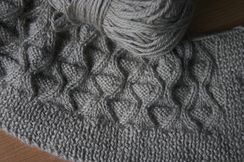
With Pinterest on the rise, crafting and DIY projects are making a comeback. Among the many crafting options, knitting and crocheting aren’t just for grandmothers anymore! For all those sweater, hat and mitten projects for this cold winter, you may be wondering what type of wool yarn to buy and the difference between them – and why alpaca yarn is a great choice!
Lamb’s Wool: This is short length wool is sheared from lambs around seven months. It is softer and more elastic than regular wool and is also lightweight but warm.
Cashmere Wool: Sheared from a Cashmere goat, the wool has to be separated from the coarser hair making it more laborious than other wools, therefore resulting in expensive wool. The end result, however, is a very fine and soft wool.
Angora Wool: This wool is actually taken from a rabbit! The Angora rabbit is known for its long, silky, fluffy fur. However, it needs to be blended with other fibers because of the lack of elasticity.
Merino Wool: This is the most common and well-known type of wool. Taken from a Merino Sheep, it is durable and helps regulate moisture and insulation.
Alpaca Wool: Alpaca wool is increasingly becoming more popular. It is as soft as Cashmere and lighter than Lamb’s wool but extremely warm. Unlike other wools, alpaca wool also doesn’t pill and is extremely durable. Also unlike the Merino Wool and Angora Wool, it is extremely soft and doesn’t leave your skin feeling itchy. Alpaca wool is also water and fire resistant!
|
|
Friday, February 6, 2015
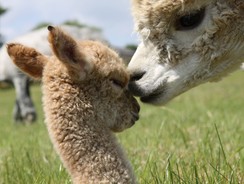
You already know that alpacas are adorable, and we’ve talked about the difference between them and llamas. Other than those tid-bits, how much more do you really know? This week I wanted to take some time to talk about some interesting things that you may not know about alpacas. As always, make sure to comment and let me know your favorite (as well as any other fun facts about alpacas that we don’t mention!).
First, let’s start out with one you many not have expected! Did you know that alpacas fiber is fire resistant?! This is just another reason that using fiber from alpacas to make clothes is a good idea! They meet the standards of the U.S. Consumer Product Safety Commission's rigid testing specifications as a Class 1 fiber for use in clothing and furnishings. So, while you’re feeling comfy and cozy in your alpaca sweater, you’ll also be free of fire (and hopefully you wouldn’t need to worry about that in the first place!). Make sure to enjoy that bonfire in your favorite alpaca wear!
Next up! Let’s talk about the history of alpacas a little! Alpacas have a very interesting history as they were domesticated by the Incas more than 6,000 years ago and raised for their amazing fleece! Naturally, because alpaca fibers are so durable and gorgeous, most of the fleece was reserved for the elite and Inca royalty! It is amazing that alpaca fiber was used do exquisitely!
Lastly, I want to mention how alpaca fiber is hypoallergenic which is very important to many people now a days! It makes a wonderful gift for this reason. Imagine how lovely it will be while wearing your favorite alpaca fleece gear and feeling warn but definitely not itchy! We all know that feeling, and personally, we could all benefit from making the switch to alpaca wool (especially our itchy skin!).
Alpacas have a rich and interesting history that spans back many amazing years!
Do you have a fun and interesting alpaca fact to share with us? We’d love to hear them!
|
|
Wednesday, September 17, 2014
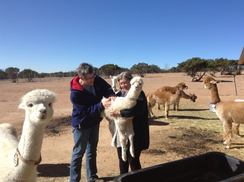
At Que Sera Alpaca Farm, we love having visitors, and one weekend one of our "regulars," Susan who is a spinner and weaver, brought a friend with her to meet the alpacas. As we were walking out to the Mom’s Pen to look at the babies, I heard her comment to her friend, “You are going to love this. Anne speaks alpaca.”
We laughed, and I admitted that I do feel like part of the herd. But I was curious as to why she felt that way. Susan proceeded to describe a previous visit. It was a day the ranch was not open to the public, and I had allowed several of the females out of their pens to "mow" the grass around the parking lot. I was herding the girls back to their pasture when Susan arrived.
I quickly realized that a few alpacas were missing, discovering then that one of the barn doors was open just a crack. It happened to be a part of the barn where we keep the alfalfa. Alfalfa is a real treat for alpacas, and at Que Sera Farm we use it primarily to entice them from one area to another. When I opened the door all the way, sure enough...I had found my missing girls.
I shooed them all out. "Everybody out of the pool,” I said, and they dutifully--and somewhat sheepishly--filed out and headed back to where they belonged. Susan thought it was all quite marvelous and her friend looked somewhat amazed.
The fact is that alpacas are extremely intelligent and are not difficult to train. All you have to do is convince them that there IS a good reason for them to do what you want them to do and that they can trust you not to get them into trouble. Piece of cake!
ARE YOU LOOKING FOR A FUN EXPERIENCE THAT'S A LITTLE OUT OF THE ORDINARY?
HOW ABOUT A VISIT TO A WORKING ALPACA RANCH?
Meet the babies (we call them cria) laugh with the Jr. Varsity boys as they work out their new plays. Visit our fiber processing area ... and of course there's Broonie, our kissing alpaca! You'll love meeting sweet Broonie. Call ANNE: 505-310-3369 to arrange an appointment.
|
|
Friday, September 12, 2014
Our gorgeous Kubota and his buddy Neville will be leaving us September 27th to begin their journey to their new home in New Hampshire. We are very excited for them…their new owner, Kitt Hollister, has a veterinary degree and seems to be just our kinda gal. She is deeply concerned about the health and wellbeing of her animals (and everyone else’s as well, methinks) and has just been a pleasure to work with. She actually purchased the boys in June, but opted to board them here until the weather improved and made things more conducive to safe travel across our very large country. We hate to see them go, but are very pleased they will have a safe and productive life at Kitt’s Howling Hill Farm. Bota is an exceptional young male – an appaloosa with amazing consistency throughout his fleece, wonderful fineness, density, conformation and coverage and we can’t wait to see his offspring.
Congratulations to Kitt and Bon Voyage to our sweet little boys.
|
|
Friday, August 8, 2014
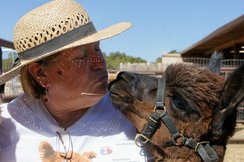
Raising Alpacas at Que Sera Alpaca
Not long ago, driving past a field of alpacas in the United States would have been a jaw-dropper. But it is becoming more and more common to see these exotic creatures in the fields of small farmers all over the United States. So what is it about alpacas that is making them a popular livestock choice?
Originally bred in South America, alpacas are raised for their fiber, which is warmer than wool by weight, softer and more comfortable than cashmere and is surprisingly strong for a luxury fiber! An adult alpaca can produce 8 to 10 pounds every year. Unlike sheep's wool, however, processing alpaca fiber is quite expensive . This is one of the reasons we also breed alpacas, and also because we are passionate about breeding the very finest animals.
There are two types of alpaca, the most common being the Huacaya. These alpacas look very fluffy because their fiber is crimped. I tend to think of them as chia pets! The other type, the Suri, has smoother, twisted locks – like ringlets – that is lustrous and very silky.
One of the most appealing things about alpacas is their demeanor. They can be shy but, are not aggressive toward humans (though the males will sometimes fight one another for dominance). Another part of their appeal is how quiet they are. Soft food pads enable them to walk very quietly in pastures, which makes them not only peaceful creatures but also very easy on the environment. They don’t tear up the pastures the way sheep and goats do.
Their normal speech consists of an easy humming sound but they can screech a bit if they are mad. And they have a very effective “alarm” cry which is loud and unmistakable. When I hear that I go see what’s got them riled up. Some people claim they actually have "calming power" over humans and I find them very therapeutic!
|
|
Wednesday, January 11, 2012
Have you ever had to work on a sick or injured alpaca? They don't much care for it, do they? I and several of my breeder friends and neighbors made a wonderful discovery last fall and I'd like to share it with you.
Alpaca Tipping - yep, it is what it sounds like. Tipping...or causing the alpaca to lay still on its side...while you do what you need to do.
I've tried it with 3 females - 2 pregnant and one immediately post partum. It worked with 2 of them, the other was having none of it.
I'll start with the happy accident that first introduced me to this little trick. I had two females that went into labor at the same time. I have the great good fortune of living in an active alpaca community and I have 2 neighbors that are always on cria watch the same time I am. It is understood - if a baby is being born everyone comes running. So I did have other folks around, but two deliveries minutes apart presents its own set of problems and we decided to place both mothers in one enclosure so we could monitor things better. Now, bear in mind, one female is medium brown and one is snow white - both bred to the same male - but still, I was expecting different looking babies from the two dams. The white female did not have an easy time of it - labor was prolonged and difficult. The brown female's cria was much smaller and delivered pretty quickly. She was up and nursing within minutes of being born. The white female finally delivered, but she was down and catatonic. So I had two beautiful white cria - one male, one female - born minutes apart - and two post partum dams - one up and happily nurturing her new baby and one down for the count. Of course, all of our attention was on the downed animal. We did all the things you do, calcium, alfalfa. poking, prodding, pleading and praying. She rallied a couple of times, but it took a while to really get her to focus on the situation at hand, but she finally started to come around. Wouldn't you know it, the minute she perked up and looked around for her baby - the wrong cria walked right in front of her. She zeroed in on that cria and would pay no attention to her own.
Of course, we immediately removed the other female and her cria from the stall and introduced her cria to her. We placed him right next to her, she sniffed him, but then looked away...looking for HER baby.
|